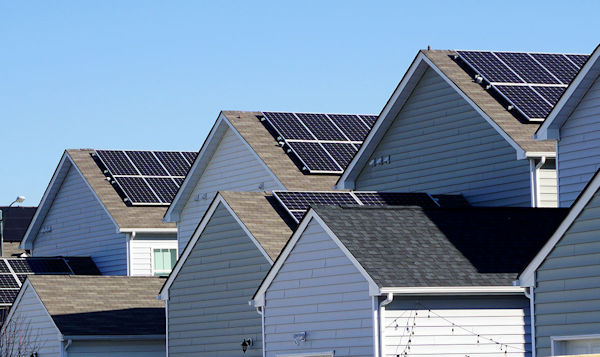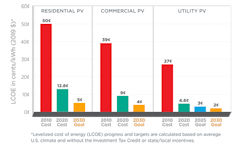SEJournal Online is the digital news magazine of the Society of Environmental Journalists. Learn more about SEJournal Online, including submission, subscription and advertising information.
 |
| Above, residential solar panels in Richmond, Va. Photo: VCU Capital News Service, Flickr Creative Commons. Click to enlarge. |
TipSheet: Solar Panel Stories Can Shine for Local, Regional Reporters
By Joseph A. Davis
Installations of solar photovoltaic panels, which generate electricity from sunlight, have surged in the United States in recent years.
Despite the pandemic downturn, the U.S. solar panel industry charged gung-ho through 2020 and its future growth looks to continue apace, whatever the obstacles. This trend holds both for the United States and worldwide.
And there may be growing federal support for panels, if and when this year’s infrastructure legislation is done and dusted.
So as solar panels make news, environmental journalists will want to get acquainted with local or regional developments to be ready.
And remember that it’s not just an energy story. It’s also a climate story, a tech story, a people story, a consumer story, a business story, a jobs story, an air quality story — and yes, even a grid reliability story.
The backstory
During the Trump administration, panels made news because Trump hated them (as did his backers in the fossil fuel industry). He slapped tariffs and trade barriers on their import, which hurt the solar industry.
The Biden administration has yet to undo much of this, although it recently banned the import of solar panels and related raw materials linked to forced labor (may require subscription) from China’s Xinjiang region.
While government policies have a lot
to do with the growth in solar, what is
really driving this trend is the market.
While government policies have a lot to do with the growth in solar, what is really driving this trend is the market. The cost of solar electricity has dropped precipitously (more than 70%) in the past decade, down to about $0.06 per kilowatt-hour for utility-scale installations — quite competitive with conventional fossil fuels.
Whatever the latest headlines about solar panels, they may well impact the manufacturing companies, the installation companies, the homeowners, the ratepayers and the electric utility companies near you.
Photovoltaic manufacturers are an important part of the U.S. solar economy, although they are hardly all of it. There are plenty of them, scattered around the country — and maybe some near you.
There are a lot of resources for finding the ones in your area. Luckily, the Solar Energy Industries Association, or SEIA, the industry’s main trade association, has an online, free, open and searchable directory of its members. You can even filter it by business type or find just those in your state. Be aware that it may not include companies that are not SEIA members.
Alternatively, there are some published online lists of solar panel manufacturing companies here, here, here, and here. It is a point of some interest whether U.S. companies use panels made in the United States. Imports from countries like China are often cheaper.
Why it matters
Remember: It’s not only about manufacturing. It’s a big industry, with many other segments. For instance, a big part of the industry is the residential installation of panels.
One of the successful early pioneers of the residential installation business was SolarCity, whose business model involved sinking its own capital into residential installations, leasing them to the homeowner for an affordable payment and then letting the homeowner reap a share of the cost-savings. SolarCity had commercial and industrial customers as well.
The business was bought out in 2016 by Tesla, which got extra advantage from its position in the battery market. There are other companies using this model, e.g., Sunrun or Vivint (which is being integrated into Sunrun). Many focus on a particular region. Most of the big national companies work through local or regional offices.
 |
| Above, cost trends for photovoltaics. Image: Department of Energy, Solar Energy Technologies Office. Click to enlarge. |
From the consumer’s standpoint, by the way, it’s not always pure sunshine. Sales tactics are aggressive.
Another angle you may want to look at is how solar panels do (or don’t) work for local and regional electric utilities. This is often highly political, and your state legislature and public utility commission may or may not put their finger on the scale at the urging of fossil fuel companies. Federal law establishes wholesale power market rules which may require your local utility to offer customers a green power source.
A word to the wise (and a sad sign of the times that we need to mention this): Green energy is an area where you will encounter plenty of misinformation. Not to mention spin, fluff, fake news, PR, disinformation and flat-out lies.
So when Texas experienced a lethal blackout this winter, politicians rushed to blame alternative energy. That was, to use a polite term, horsepucky.
Story ideas
- Are there many solar panel-related jobs in your locality or region? Ask local companies whom they employ.
- Does your state or utility encourage or discourage photovoltaic customers with “feed-in tariffs?”
- As federal infrastructure legislation advances (or crashes) this year, ask local companies and utilities how it will affect them economically.
- What is the energy diet of your regional utilities? Coal? Gas? Solar? Wind? Hydro?
- Canvass local customers of solar leasing firms about their experience with price and performance.
- Is utility-scale photovoltaic tech being implemented in your area?
Reporting resources:
- Energy Department: One of the main federal agencies working on photovoltaics.
- Energy Information Administration: A comprehensive, updated and relatively objective source of statistics.
- Solar Energy Industries Association: A trade association advocating industry interests.
- International Energy Agency: A global multinational (not affiliated with the United Nations) that offers decent energy statistics.
- pv magazine: A trade publication that covers the photovoltaic industry.
- Solar Power World: A trade publication that covers the solar industry.
- Canary Media: An nonprofit journalism outlet, affiliated with RMI, that covers energy transition.
- Greentech Media: A media company, part of the Wood Mackenzie equity research firm, covering green technology.
Joseph A. Davis is a freelance writer/editor in Washington, D.C. who has been writing about the environment since 1976. He writes SEJournal Online's TipSheet, Reporter's Toolbox and Issue Backgrounder, as well as compiling SEJ's weekday news headlines service EJToday. Davis also directs SEJ's Freedom of Information Project and writes the WatchDog opinion column and WatchDog Alert.
* From the weekly news magazine SEJournal Online, Vol. 6, No. 26. Content from each new issue of SEJournal Online is available to the public via the SEJournal Online main page. Subscribe to the e-newsletter here. And see past issues of the SEJournal archived here.














 Advertisement
Advertisement 



